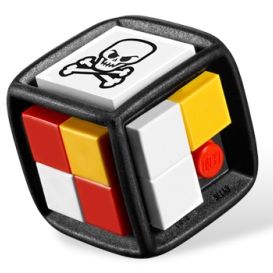I have mixed feelings about novelty randomisers.
Novelty randomisers aren't new to roleplaying games - Crimson Cutlass , for example, used Tarot cards as a randomiser in 1979 - but I'm guessing most gamers are familiar with more recent examples such as Deadlands' playing cards and poker chips or Dread's Jenga tower. Once in awhile a would-be game designer at Big Purple pops up with an idea for some other means of generating random outcomes - my impression is usually that it's less about the outcome and more about the novelty, a grab for attention.
And yet, I think, Hmmm, swashbucklers dueling in a burning building, or a ship drifting toward a dangerous reef - the Jenga tower would be perfect for modeling that!
Perhaps that explains my fascination with LEGO dice.
We picked up the LEGO board game Pirate Plank on a trip to LEGOLAND last year - the image at right is the buildable die from that game. In Pirate Plank, the goal is to avoid walking the plank. During the game, you roll the (initially blank) die - you can either add a color tile matching that of one of the other players' pieces, or, if color tiles are already on the face, you may move an opponent's piece a number of spaces equal to the number of matching color tiles. The skull-and-crossbones face allows you to either move one of your opponents' pieces one space forward or your own piece two spaces back. Each turn then presents a choice of move your opponent now or build up as many colors on the die face as you can and move your opponent's piece further later in the game. My son - who picks up game strategy incredibly quickly - and I play this one quite often.
The LEGO die frames just call out to me for a roleplaying game application - and I'm not the only one, apparently. In that thread I noted that the LEGO die makes a useful condition track - each tile could represent something like a successful skill check, frex.
I considered adding the LEGO die to the Flashing Blades dueling system - each round in which you successfully hit an opponent without being hit in return allows you to roll the die and either add a tile or use the number of tiles of your color as a bonus to an attack or parry in the next round. I was reminded of this by the Honor + Intrigue Advantage track earlier this year.
One of the great things about the LEGO die as a condition track is that once a tile is added to the frame, it stays there until it's removed, so it allows a condition to be tracked over long periods of time without note-keeping - and it can't be bumped off the track when a character sheet gets jostled. With this in mind, I looked at ways to use the LEGO die with the homebrew courtier minigame rules I'm picking away at. One possible application is tiles on the the LEGO die representing the circle of the King's closest courtiers - each time the adventurers either gain one of the courtiers as a Contact or gains a Favor from one of these courtiers, or even potentially takes over one of those positions, the color changes to that of the character. Anytime the adventurers attempt to sway the King to their course of action, the die is rolled, and the difference between the number of the adventurers' tiles and that of the other courtiers becomes a bonus or penalty to the die roll. This allows me to track the extent of the characters' influence at court over a long period of time.
While both of these applications - and another half-dozen or so floating around in the corners of my mind - appeal to me, I'm also acutely aware that I have a solution in my hand while searching for problems to fix with it, which is really kind of an ass-backwards way to do things - novelty for novelty's sake. It's why I haven't actually unveiled any of my own stupid dice tricks just yet.


Mike,
ReplyDeleteI was baffled when I first saw Pirate's Plank but your explanation makes a lot of sense.
I'll confess I don't understand your example of using it to represent increased influence at court, but perhaps I'm just making it too complicated in my mind.
Having considered for a few days, and reread the post a couple of times, I think I understand.
ReplyDeleteI'm not sure, having given it so much thought, that this really is novelty for novelty's sake. You have a problem, however ill-defined, and this struck you as a possible solution. As you refine the solution and further define the problem, you'll hit a point where it makes sense. And when you present it to your players they'll wonder why they didn't see it before.
:D